Strawberries are the earliest fruit to harvest in spring. Strawberries also come to harvest in summer and fall, and in winter as well in many regions—if you plant the right varieties.
Strawberries are easy to grow but they do require some attention to ensure a bountiful crop.
Choose cultivars that grow well in your region. Give each plant a square foot of space. Keep the soil just moist. Keep runners under control (and use them to start new plants). Protect plants from frost in spring and freezing temperatures in winter. Harvest at the peak of ripeness, not later. Clean planting beds thoroughly at the end of the season.
A strawberry plant will be productive for three years then it must be replaced. Following a simple cycle of care and renewal, your strawberry bed will produce this sweet crop for years.
Related articles:
Here is your complete guide for growing strawberries.
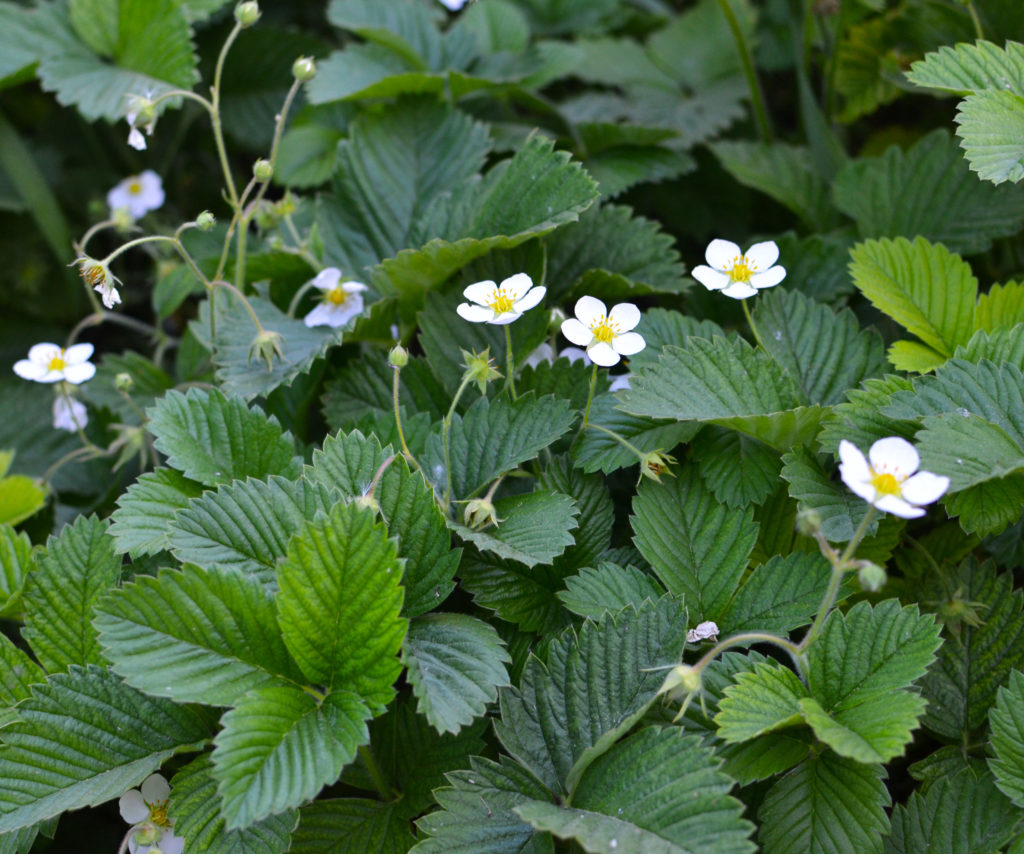
Best climate and site for growing strawberries
- Strawberries grow best in Zones 3 to 10; some cultivars are colder tolerant than others. Choose cultivars appropriate for your climate.
- Grow strawberries in full sun. Day-neutral strawberries can tolerate light afternoon shade.
- Plant strawberries in compost-rich, loamy soil with excellent drainage. Where drainage is poor, plant strawberries on a mounded or raised bed.
- Avoid planting strawberries in low spots where cold air or frost can linger and injure spring blossoms. Do not plant strawberries where there is a constant wind or breeze.
- Avoid planting strawberries where peppers, tomatoes, potatoes eggplant, melon, okra, mints, raspberries, blackberries, or roses have grown before. Diseases that attack these plants can remain in the soil and attack strawberries.
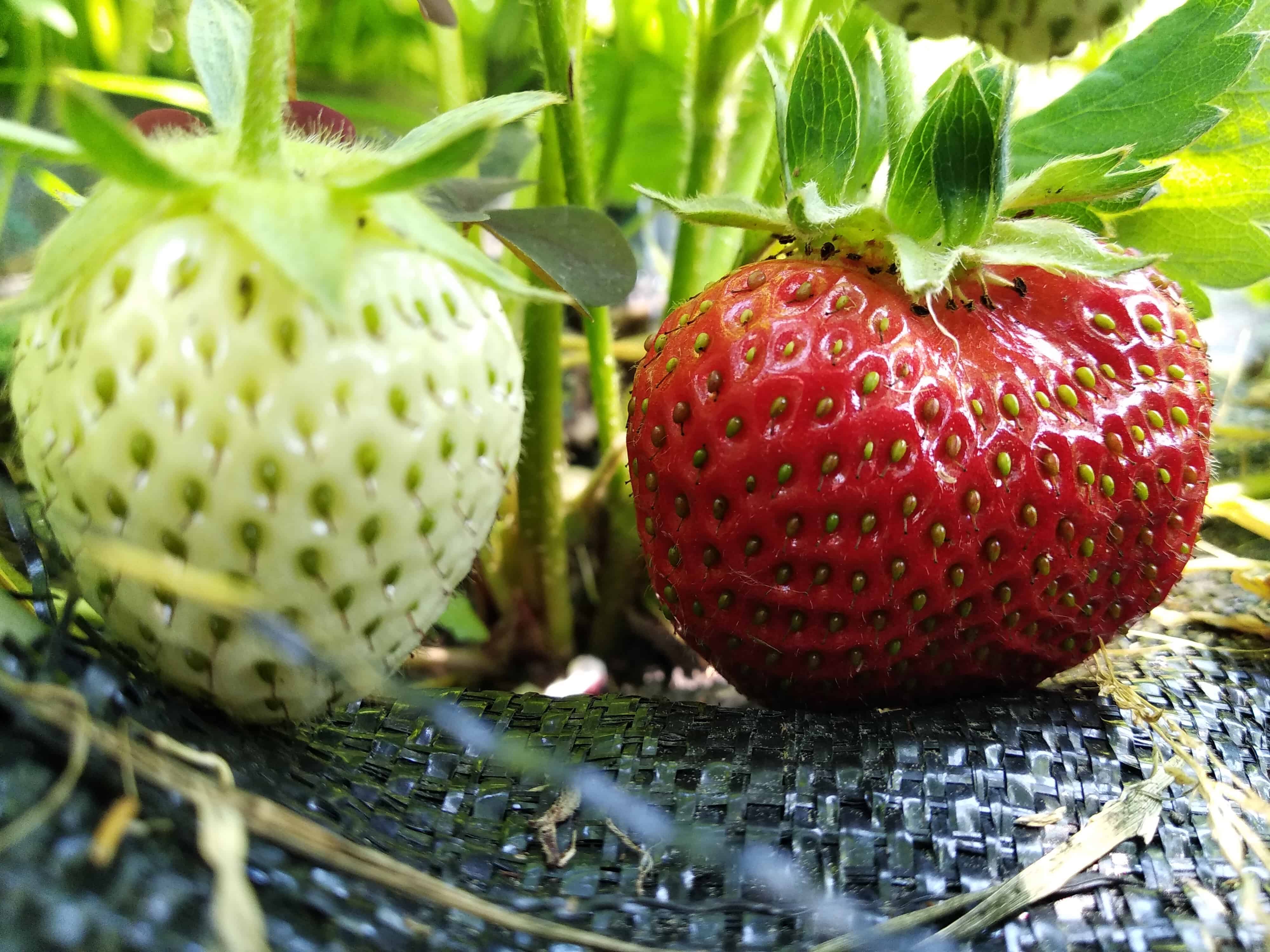
Temperature and strawberry yields
Strawberry plants require a period of winter chill between 34°F and 55°F to ensure vigorous growth and complete development of flower buds the following spring. (This is essential for fruit production.) If there is insufficient chill, plants will grow poorly and produce few berries. If the chill is too great, plants will grow strong but fruit production will be delayed.
Best strawberry production in warm-winter regions. To ensure the optimal berry yield in warm-winter regions, chill strawberry runners before you plant them. Gather runners together with a minimum amount of soil around their roots and place them in a plastic bag and set them in the refrigerator (low in the refrigerator near the vegetable drawer) for 20 days before planting. Pre-chilling will fool strawberries into thinking they had a cold winter.
Best strawberry production in cold-winter regions. Where winters are cold, protect strawberry plants–both young and old–from too much chill by covering plants with straw, pine needles or boughs, or spun-poly garden blankets. Pull the mulch away in early spring to allow the ground to warm and to allow bees to pollinate flowers when they open.
Strawberry plants that have set down good roots will be stimulated to produce fruit as soon as the ground warms and days lengthen in spring. Setting out runners in spring or in fall before the soil cools will give plants enough time to establish roots for strong growth and fruit production the next spring.
Good Products for Growing Strawberries at Amazon:
- Garden Safe Snail and Slug Bait
- Bonide Sulfur Fungicide
- Monterey BT Caterpillar Killer
- Neem Bliss 100-% Cold Pressed Neem Oil
- Safer Brand Insect Killing Soap
- PyGanic Botanical Insecticide
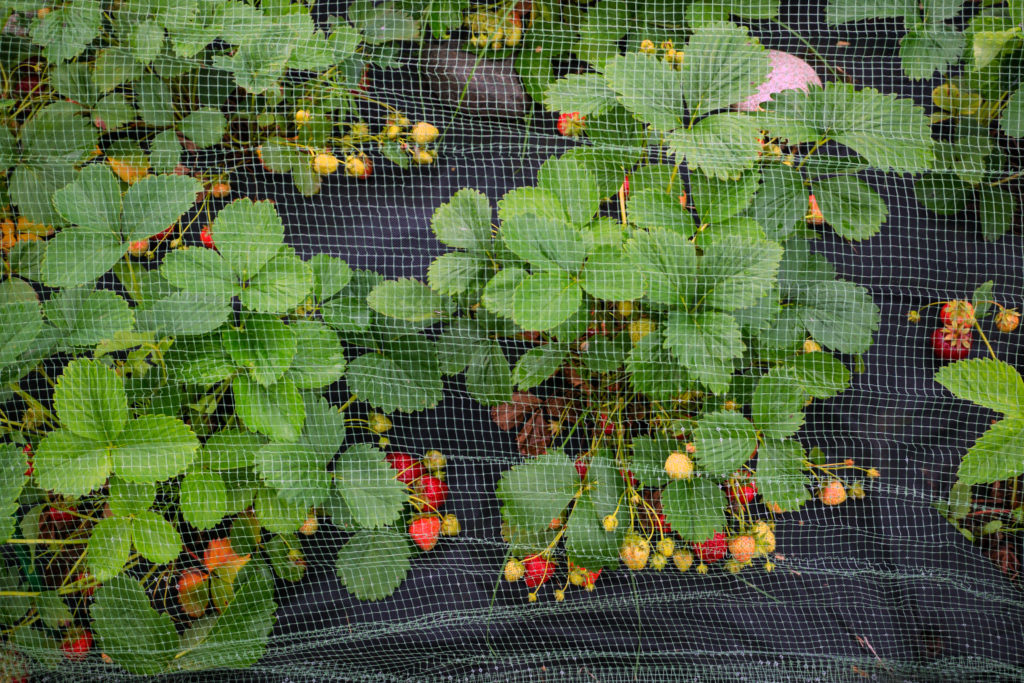
Types of strawberries
There are four types of strawberries: (1) June-bearing strawberries are available in both early and late-season varieties; choose one best suited for your climate and planting schedule. June-bearing strawberries produce a large crop in June or early July. (2) Ever-bearing strawberries produce two or three small crops throughout the growing season, typically in June, August, and September. (3) Day-neutral strawberries produce small crops throughout the season, regardless of the length of day. (4) Alpine strawberries are wild berries that have a more complex flavor than traditional strawberries; they do not produce runners and are ideal for growing in containers and small spaces due to their compact size. An Alpine strawberry will be about half the size of a traditional strawberry.
June-bearing strawberries
- June-bearing (also called summer-bearing): these strawberries ripen a single crop each year, usually in late spring or early summer. These strawberries will set fruit the year after they are planted.
Ever-bearing strawberries
- Ever-bearing: these strawberries bear two crops each year; the first crop comes in summer and is small; the second crop comes in fall and is larger. Ever-bearers produce their first crop the same year they are planted. Sometimes they are grown as annuals and not wintered over for a second or third year. Ever-bearers grow best where late summer weather is cool, not hot.
Day-neutral strawberries
- Day-neutral: these strawberries bear fruit in spring, summer, and fall–throughout the growing season as long as the temperature remains between 35°F and 85° They will even produce fruit in winter if temperatures do not drop below 35°F. Day-neutral strawberries were developed from everbearing strawberries. They will bear fruit about 12 weeks after planting. They can be grown as annuals.
Alpine strawberries
- Alpine: these wild strawberries bear very small, very flavorful fruits from late spring through fall. The yield is very small. They are grown from seed, not runners, unlike other strawberries.
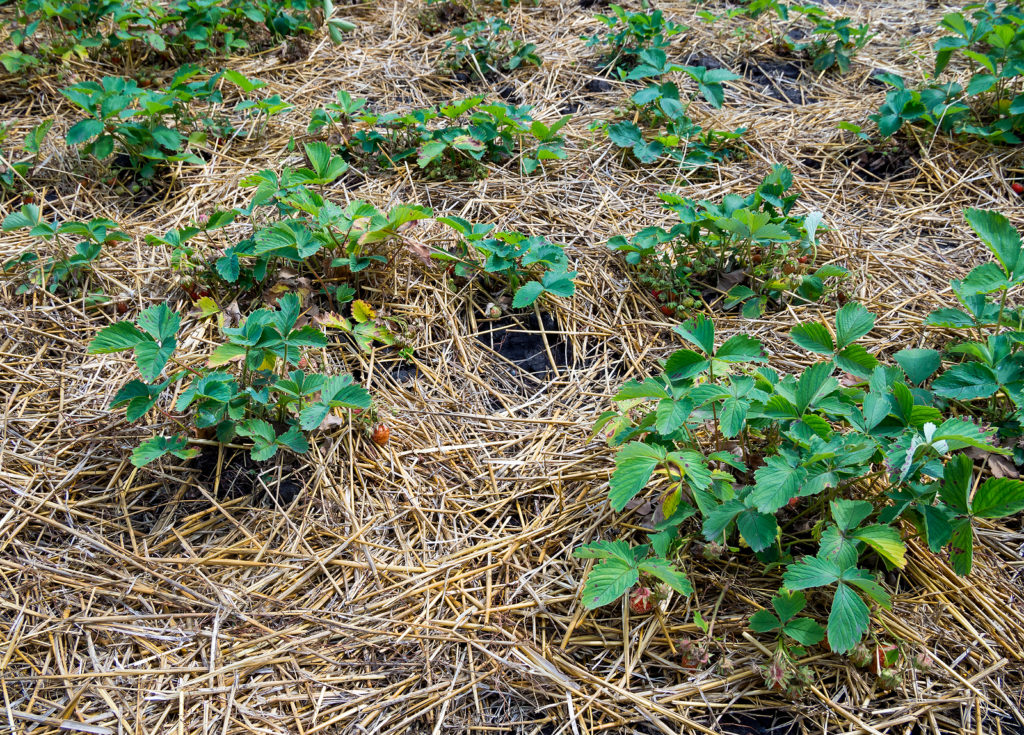
Choosing strawberries
- Purchase certified disease-free strawberries if you are growing plants from runners. Strawberries are susceptible to the diseases Verticillium wilt, red stele, and leaf spot and they are subject to viral diseases. Plant disease-free plants.
- Consider fruit size, firmness, and flavor intensity when selecting strawberries to grow. Plant labels will describe the fruit. Firmer fruit cultivars are better for freezing and preserving.
- Choose a combination of early harvest, mid-season harvest, and late-season harvest cultivars to extend the harvest. Plant two or more cultivars with differing harvest times to spread out the harvest season. See Types of Strawberries above.
- Consider the number of runners a plant will produce. Runners can be rooted to start new plants, but they also can overrun a planting bed if they are not controlled. Runner production increases in number from day-neutral (the fewest) to ever-bearing to June-bearing types; alpine strawberries to not send out runners.
Strawberry pollination
- Strawberries are self-fruitful. You need only one plant to produce fruit.
Strawberry yield
- June-bearing, everbearing, and day-neutral strawberry plants will produce a half-pound to one pound of fruit each season, about a quart of berries per plant. Alpine strawberries produce a quarter of that amount.

Strawberry planting overview
- Grow strawberry plants from seed, crowns, or runners. Crowns are divisions of existing plants that have roots. A runner is a stem that roots at nodes along the stem.
- Runners are easily harvested from mother plants; simply find a node that has rooted and cut the stem or runner away from the mother plant.
- Sow seed indoors 8 weeks before setting out new plants in early spring. Plant after all danger of frost has passed.
- Sow seed ¼ inch (6 mm) deep in a lightly moistened seed starting mix.
- Seeds will germinate in 7 to 14 days at 65-75°F (18-24°C).
- Transplant seedlings to the garden when plants are 6 to 8 weeks old and the soil temperature is at least 60°F (15°C).
- Set out root divisions or “crowns” or runners in early spring about 2 weeks after the last frost.
- Each crown or runner should have a rooted section; plant the crown or runner so that the topmost roots are ¼ inch below the surface; the leaves should be just above the soil level. A buried crown will rot.
- If possible, plant strawberries on hills or raised mounds and allow the runners to run away from the crown of the plant down the hill.
- Space plants 12 inches (30 cm) apart in every direction.
- Keep the growing medium or soil in which seeds or crowns are planted just moist.
- Fertilize with fish emulsion or a soluble complete fertilizer at half strength.
- Add aged compost to planting beds in advance of transplanting.
- Strawberries prefer a soil pH range of 5.5 to 7.0.
- Grow strawberries in full sun for the best yield.
- Plant strawberries in a dedicated bed; plants will live about 2 to 3 years or so, but established plants are always sending out runners to establish new plants.
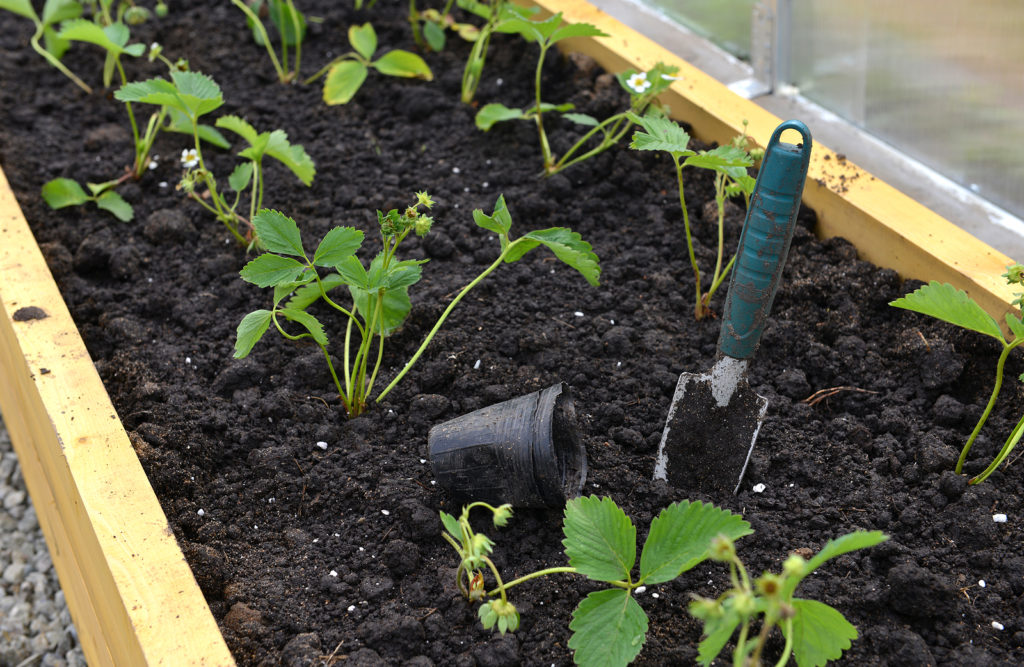
Where to plant strawberries
Strawberries prefer full sun and temperatures between 60-80ºF (16-27ºC). They grow best in growth zones 3-10. You can grow strawberries in light shade.
Plant strawberries in well-drained acidic soil. Plant on a mound 5-6 inches (13-15cm) tall if your soil drains poorly. You can also grow strawberries in a container. Choose a container at least 6 inches (15cm) deep.
Strawberries are best grown in a dedicated bed where plants are allowed to run and establish new plants.
Strawberry planting calendar
- 6-8 weeks before the last frost in spring start seeds indoors.
- 2-4 weeks set seedlings out into the garden.
- From crowns or runners: set crowns in the garden in spring about 2 weeks after the last frost in spring; runners can be separated from the mother plant and re-planted in the garden or in pots at any time during the growing season.
Starting strawberries indoors
Strawberry seeds can be started indoors 8 weeks before setting seedlings out into the garden. Young plants can be transplanted out after all danger of frost has passed in spring or in late summer or autumn.
If you live in a cold winter region, sow strawberry seeds indoors 8 weeks before setting out the plants in early spring. Transplant the seedlings outdoors after all danger of frost has passed. Strawberry seeds should be sown ⅛-¼ inch (3-6 mm) deep. You can also plant “offsets” which are strawberry runners that have rooted.
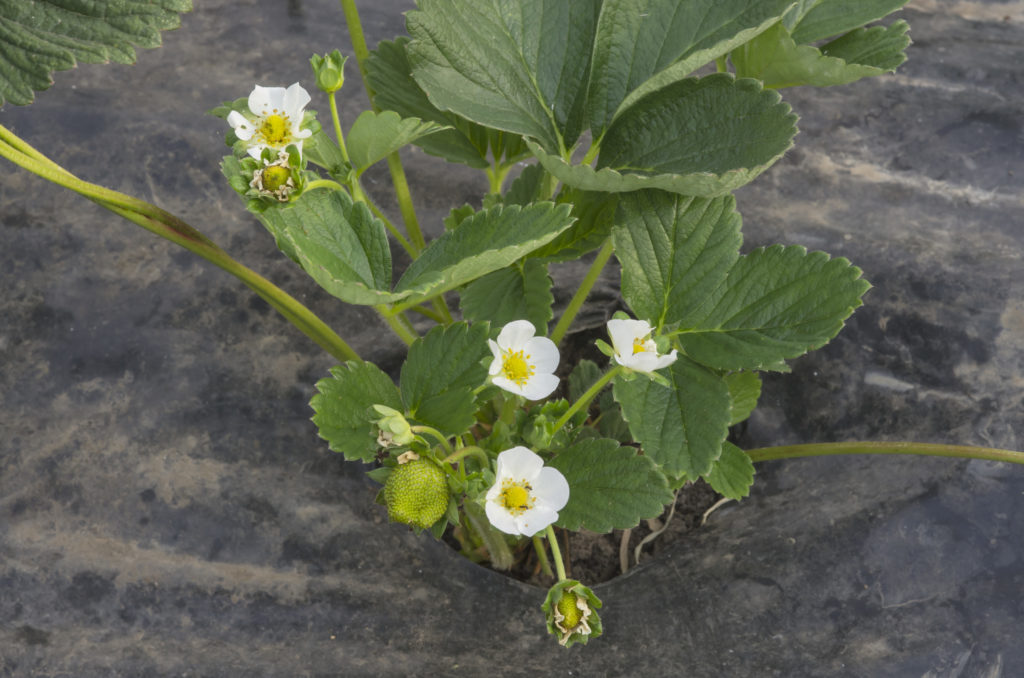
How to plant strawberries
If you live in a cool or warm winter region, set out everbearing plants in spring for summer and autumn harvest, and set out June bearers in late summer or autumn for harvest the next spring.
If you are looking for a quicker way to harvest, plant bare-root crowns instead of seeds. Bareroot crowns are the roots and top growth of strawberry plants that were grown on last summer.
Plant seeds, seedlings, or crowns 12-14 inches (30-36 cm) apart. Crown leaves should be planted just above soil level; a buried crown will rot. To grow larger plants, plant on small hills and allow the strawberries to cover the hill. Strawberries grow 6-8 inches (15-20 cm) tall and about 12 inches (30 cm) wide.
- In cold winter regions, Zones 3 to 6, plant strawberries in early spring. In mild winter regions, Zones 7 to 10, plant strawberries in spring, fall, or late winter.
- Plant bare-root strawberries in spring or fall. Avoid planting bare-root or container-grown strawberries in hot, dry weather.
- Prepare the planting bed ahead of planting strawberries. Remove all perennial weeds. Dig in plenty of aged compost or commercial organic planting mix ahead of planting. Strawberries prefer a soil pH of 5.5 to 6.5.
- Prepare a planting bed or mound 6 inches high and 24 inches wide. Allow four feet between mounds or planting rows. Mounded or raised beds increase early rooting and promote better first-year growth.
- Matted row planting system: June-bearing strawberries that produce lots of runners can fill up space fast. Create a planting bed 18 to 24 inches wide. Space plants 1 to 2 feet apart in all directions. Allow the runners to spread out, root, and fill in the open space. Mow along the edges of the planting bed to keep plants from growing into the walkways. If you allow the runners to root wherever they touch down, you will be following the matted row system. This planting method requires the least amount of maintenance. This method allows runners to constantly form baby plants for next year’s production.
- Hill planting system: use this planting method for ever-bearing or day-neutral strawberries; set plants in double, raised (or hilled) rows; space the rows 18 inches apart. Space ever-bearers 12 inches apart and day-neutrals 7 inches apart. Stagger the plants (plant in a zig-zag) across the two raised rows. Regularly pinch out all runners that form. Select cultivars that don’t make a lot of runners.
- To reduce soil moisture evaporation and keep down weeds, a row can be covered with plastic sheeting or mulch. Cut X-shaped slits in the plastic; plant through the slits into the soil.
- Dig a hole twice as wide and half again as deep as the roots of the plant. Make a cone of soil at the bottom of the hole so that roots can fan out from the top of the cone.
- Sprinkle bonemeal in the planting hole.
- Moisten the roots of bare-root strawberries before planting; soak the roots in compost tea for 20 minutes before planting. Cut the roots of bare-root plants back to 5 inches with a pair of scissors before planting.
- The crown of the plant should be just covered with soil, but not buried. New leaf buds in the center of the plant should be exposed and level with the surrounding soil. Roots should never be exposed.
- Place straw around each plant if you did not cover the planting bed with plastic sheeting. The straw will keep fruits from touching the soil. Straw mulch will keep the berries up off the soil and allow air to circulate beneath the fruit.
- Water in newly planted plants and keep the soil evenly moist going forward.
- Pinch our all flower buds for three months after planting so plants can channel energy into growing strong roots.
Spacing strawberries
- Allow one square foot for each plant. Space plants 1 to 2 feet apart.
Interplanting strawberries
Strawberries are best planted in a dedicated bed. Strawberries grow well with melons, but avoid planting them where cabbage family crops have recently grown.
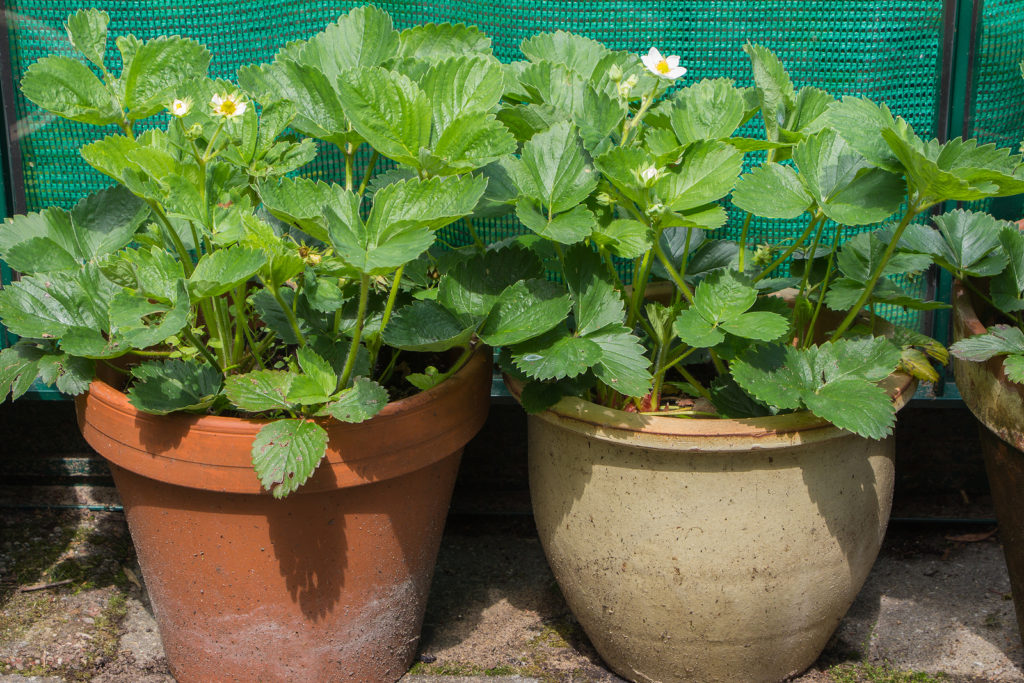
Container growing strawberries
Strawberries grow well in containers. Choose a container at least 12 inches (30 cm) deep and just as wide for a single plant.
The container should be large enough for plants to develop strong roots and spread out. The container should have drainage holes. Clay or terracotta are popular choices as they are porous and allow air and water to circulate freely. Plastic containers are light, durable, and retain moisture well. Grow bags are light and easy to move, but may require frequent watering
Grow compact strawberry varieties in containers. Choose cultivars with few runners such as day-neutral or Alpine strawberries. Everbearing strawberry varieties are a good choice for container growing; popular overbearing varieties are ‘Albion’, ‘Quinault’, and ‘Seascape.’ June-bearing strawberries are available in both early and late-season varieties; choose one best suited for your climate and planting schedule. June-bearing strawberries produce a large crop in June or early July. June-bearing varieties to grow include ‘Earliglow’, ‘Jewel’, and ‘Tillamook’. Ever-bearing strawberries produce two or three small crops throughout the growing season, typically in June, August, and September. Day-neutral strawberries produce small crops throughout the season, regardless of the length of day.
- Use a commercial potting mix in each container. You can add organic matter such as aged compost or coconut coir to help the soil retain moisture.
- Keep the soil evenly moist throughout the growing season; do not let the soil dry out.
- Once flowering begins feed plants with a dilute solution of fish emulsion once a week.
- Strawberries need 6 to 8 hours of sunlight each day. As needed, move containers to a sunny location.
- Keep containers raised off the ground to protect plants from snails and slugs and also to allow for free draining of water.
- Containers can be brought indoors in winter to continue the harvest; plants need abundant light and cool temperatures indoors.
- Replace plants every two or three years.
Watering strawberries
Strawberries prefer soil that is just moist, but not wet and don’t let the soil dry out.
- Keep the soil evenly moist, especially from flowering until fruits start to color; when fruits begin to mature let the soil surface dry between waterings. Strawberries are shallow-rooted and need even moisture, especially in dry weather.
- Water at the base of plants; wet leaves and fruit can trigger gray mold or leaf spot diseases. Soil that is not well-drained can cause root rot disease.
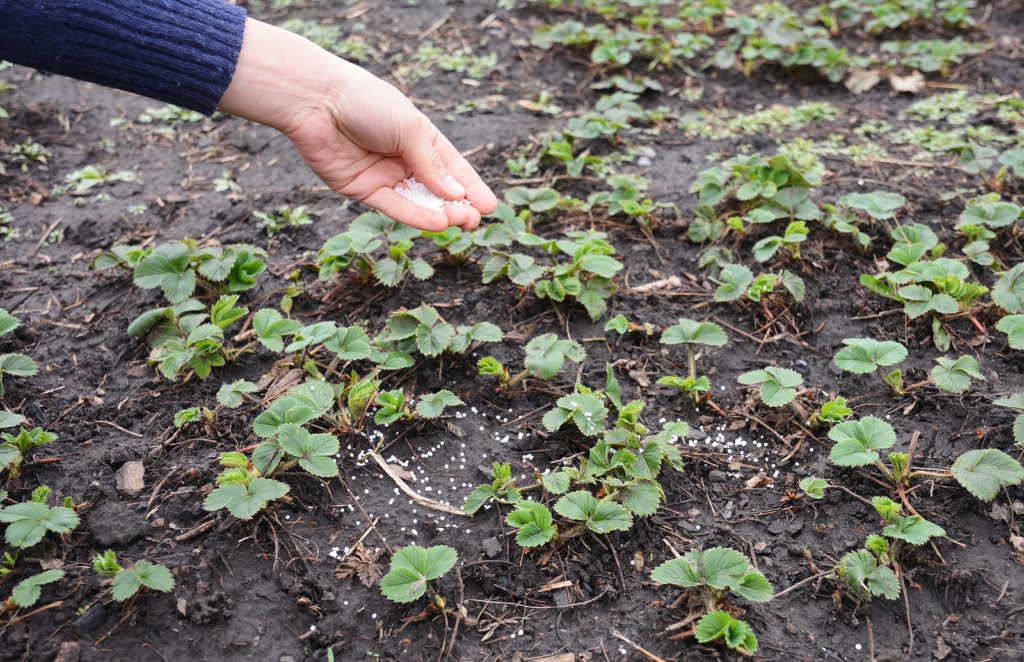
Feeding strawberries
Strawberries like a moderate amount of nitrogen, phosphorus, and potassium. Nourish strawberries with compost tea every couple of weeks and avoid using a concentrated fertilizer. Heavy feeding will lead to excessive growth, soft rot, and fruit rot.
- Kelp spray improves fruit set and enhances bud hardiness; spray blossoms prior to full bloom.
- Apply compost tea to June- and ever-bearers once in early summer; apply compost tea to day-neutral plants once a month during the growing season.
- Feed strawberries with an organic time-release fertilizer in spring. Use an all-purpose fertilizer such as 5-5-5.
- Overfertilizing and overwatering strawberries will increase the yield but compromise flavor.
Strawberry care and maintenance
- Keep planting beds weeded. Weeds compete for nutrients, moisture, and sunlight.
- Place fresh straw between the rows in spring; straw will help conserve soil moisture, reduce weeds, and keep fruits up off the soil. Mulch will reduce the spread of disease spores in splashing rain or irrigation.
- Plastic mulch can be used in cooler regions where the plastic will increase the soil temperature and keep berries off the soil.
- Pinch off flowers on newly planted strawberries until early summer. Late winter and spring flowers are susceptible to frost damage.
- Renovate beds right after harvest; this will slow the buildup of disease organisms. Thin plants removing older and diseased plants; leave the youngest and most vigorous.
- Remove surplus runners; cut them off close to the parent plant with sharp pruners; pot them up or replant them in the garden.
- Renovate strawberry beds after harvest each year. Remove three-year-old plants making room for more productive younger plants. Also, remove excess young plants; each plant should have about one square foot of space. Removed young plants can be transplanted to another bed.
- If space allows, replant in a new location every two or three years. The new bed will begin producing when plants in the old bed are finished.
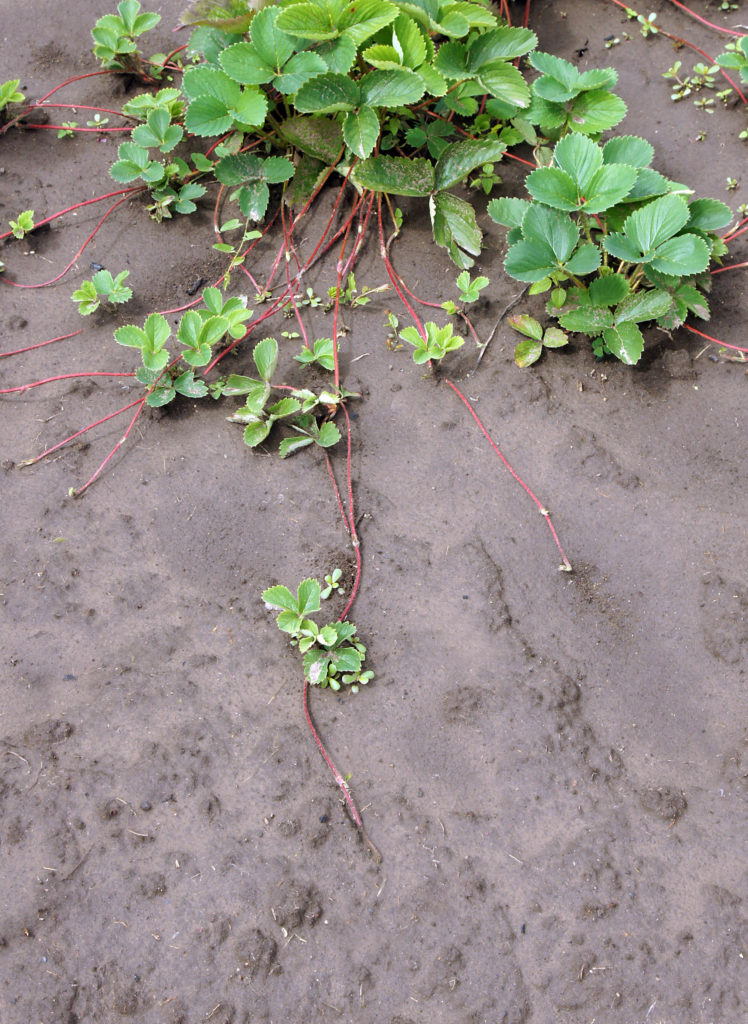
Propagating strawberries
- Most strawberries propagate themselves by runners; the mother plant sends out runners soon after producing fruit. Runners tip root about a foot away from the mother plant.
- Transplant rooted runners to start new plants
- If a plant makes few runners; you can divide the crown with a sharp knife and replant the crown pieces.
Starting strawberry plants from runners
Strawberry plants are perennials. A strawberry plant will bear fruit for 2 to 3 years. A single plant will send you several runners towards the end of each season; these runners easily establish themselves as new, independent plants.
Use runners from existing strawberry plants to start new strawberry beds each year to maintain sufficient yield from your home garden.
Strawberry plants are productive for three to five years. As time goes by, aging plants yield smaller and fewer berries. Renewing your strawberry patch each year will ensure you never run low of tasty berries.
Spring is a good time to start strawberries from seed (but not all varieties are available in seed). Fall is a good time to cut runners from existing plants and re-plant them to establish new plants. Fall-planted runners will produce a crop the following spring; spring-planted runners will not produce berries until the following spring.
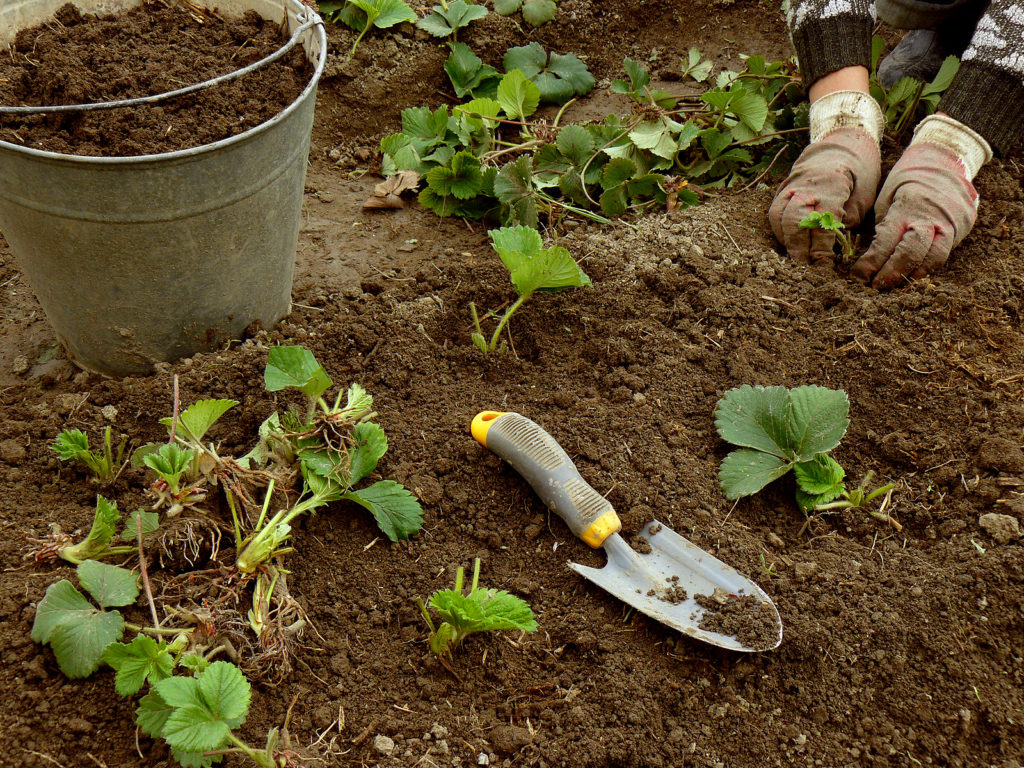
Starting runners step-by-step
- Gently dig up or cut the stem that connects the runner from its parent plant. It is best to keep the soil around the runner’s roots intact.
- Clip all but two or three of the leaflets from each new little plant.
- Set strawberries from runners in new beds–about 6 to 8 inches apart. The plants from the old beds can be put in the compost pile once runners are taken and planted in the new bed. Plant something else in the old bed.
- Dig a hole in the new bed large enough to plant the runner—a hole 3- to 5 inches wide should do. Set the little plant in place and firm the soil around the roots.
- Water the new plants. A mix of water and liquid fish-and-seaweed emulsion will give the new plant just the right boost.
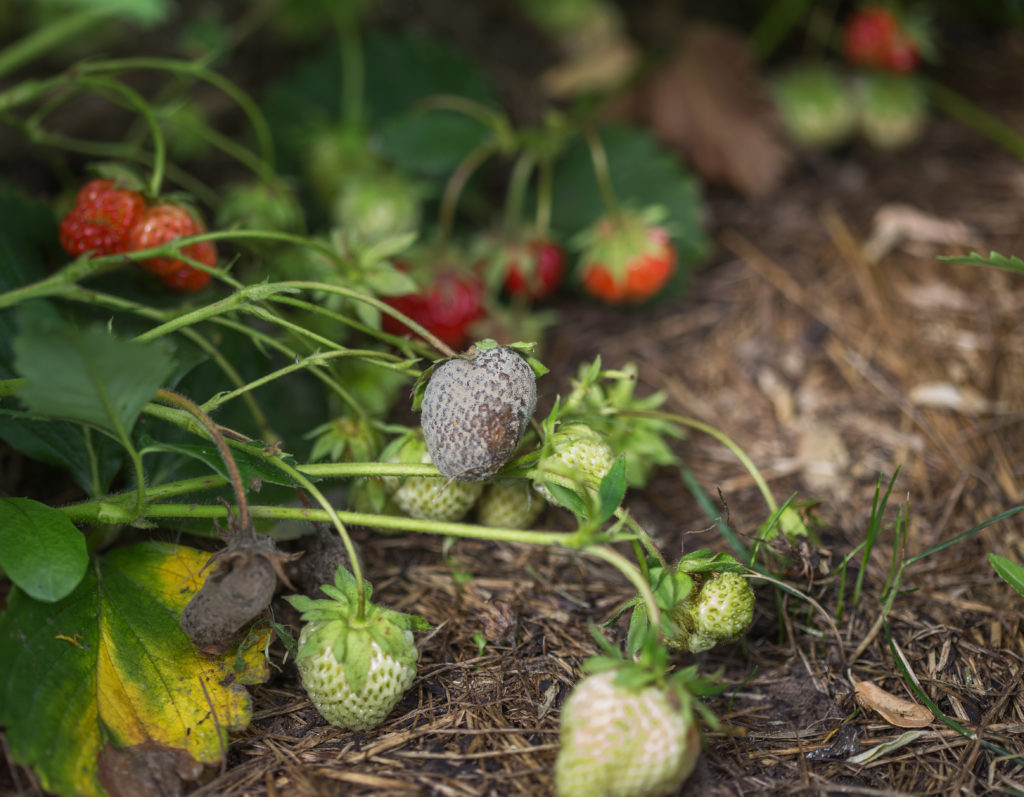
Strawberry diseases
Strawberries are susceptible to botrytis fruit rot, leaf spot, and leaf scorch. Control disease with clean cultivation and plant in well-draining soil. Mulch under fruit with straw or other organic material to prevent fruit rot and to deter weeds.
- Gray mold (Botrytis blight) produces a fuzzy gray coating on blossoms and berries; remove and destroy damaged flowers and fruits; harvest fruits frequently before they become infected; spray plants with compost tea, a natural fungicide.
- Red stele (root rot) causes plants to wilt. To check for red stele, dig up wilted plants; if there are no side roots or the roots are reddish inside when cut lengthwise, red stele is to blame. Remove and destroy infected plants. Plant stele-resistant cultivars such as ‘Allstar’, ‘Delite’, ‘Guardian’, ‘Surecrop’, and ‘Tristar’.
- Verticillium wilt is a fungal disease that causes older leaves to turn red or brown and young leaves to turn yellow and wilt. There is no cure; remove and destroy infected plants. Plant disease-resistant cultivars include ‘Allstar’, ‘Blakemore’, ‘Delite’, ‘Robinson’, ‘Surecrop’, and ‘Tristar’.
- Leaf spot is a fungal disease that causes small brown or gray spots on leaves; leaf tissue deteriorates and dies; eventually, leaves will drop. Remove dropped leaves from plantings; clean beds at the end of each season. Plant disease-resistant cultivars include ‘Blakemore’, ‘Delite’, ‘Earlibelle’, and ‘Surecrop’.
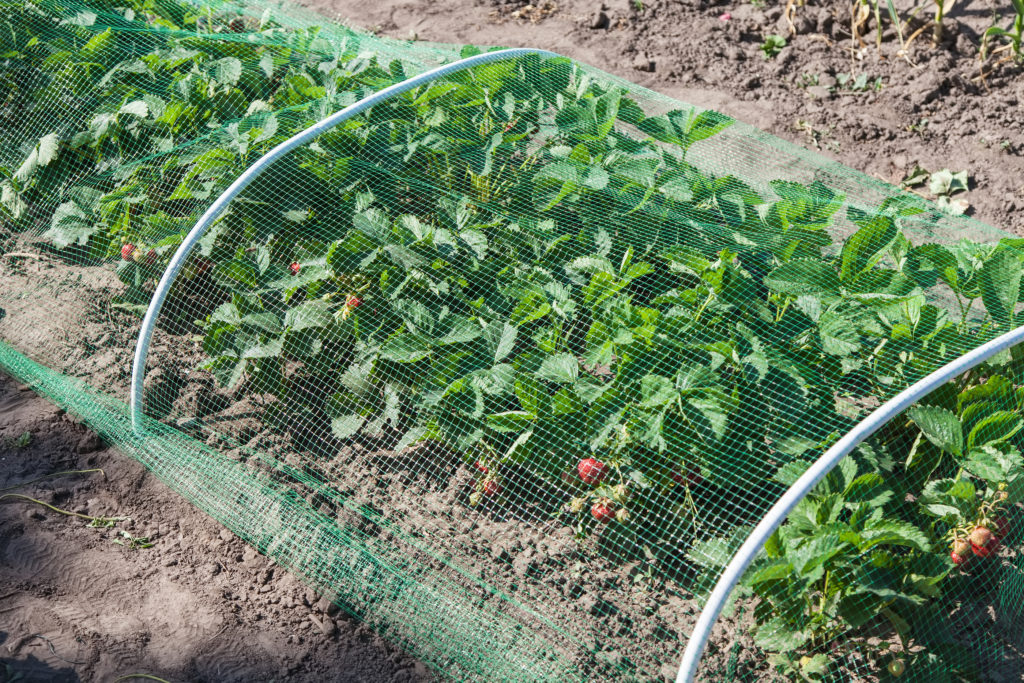
Strawberry pests
Birds and mice like strawberries. Protect strawberries with a floating row cover or netting.
- Crown moth larvae or crown borers are white grubs that will hollow out the center of the crown as they feed. Remove and destroy infected plants. Set out traps for adult moths.
- Slugs eat leaves and fruits. Exclude these pests by handpicking and destroying them, sprinkling diatomaceous earth around beds, or trapping them in shallow saucers of beer where they will drown.
- Tarnished plant bugs are small green or brown bugs that feed on fruits and cause them to be distorted; cover plants with a floating row cover while the fruit is developing to exclude these pests.
- Birds feed on berries; cover planting beds with bird netting.
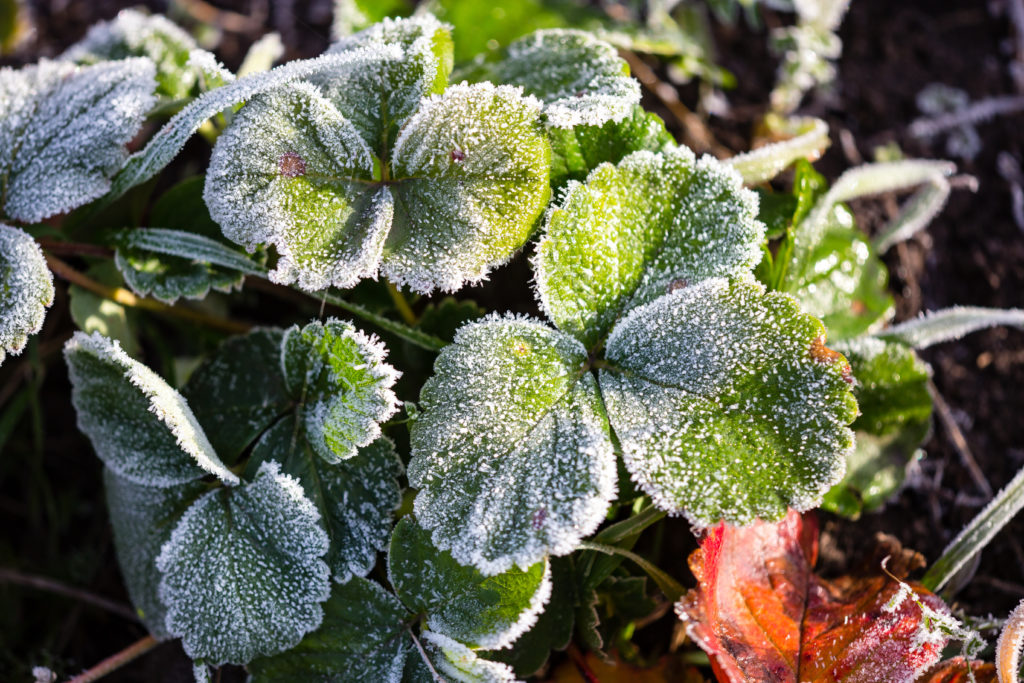
Fall and winter strawberry care
- At the end of the season mow or cut off the leaves of all strawberry plants; place the leaves in the trash. Plants will grow new leaves the following season. Leaves that remain in the garden can harbor disease.
- Remove three-year-old plants in winter; also remove unwanted younger strawberry plants.
- In early winter cover plant crowns with 2 or 3 inches of straw to prevent cold damage; plants can be damaged by winter freezing and thawing; the plant can be heaved from the soil and roots are broken.
- Pull back or remove the mulch in early spring when plants begin to grow again; add fresh straw between the rows.
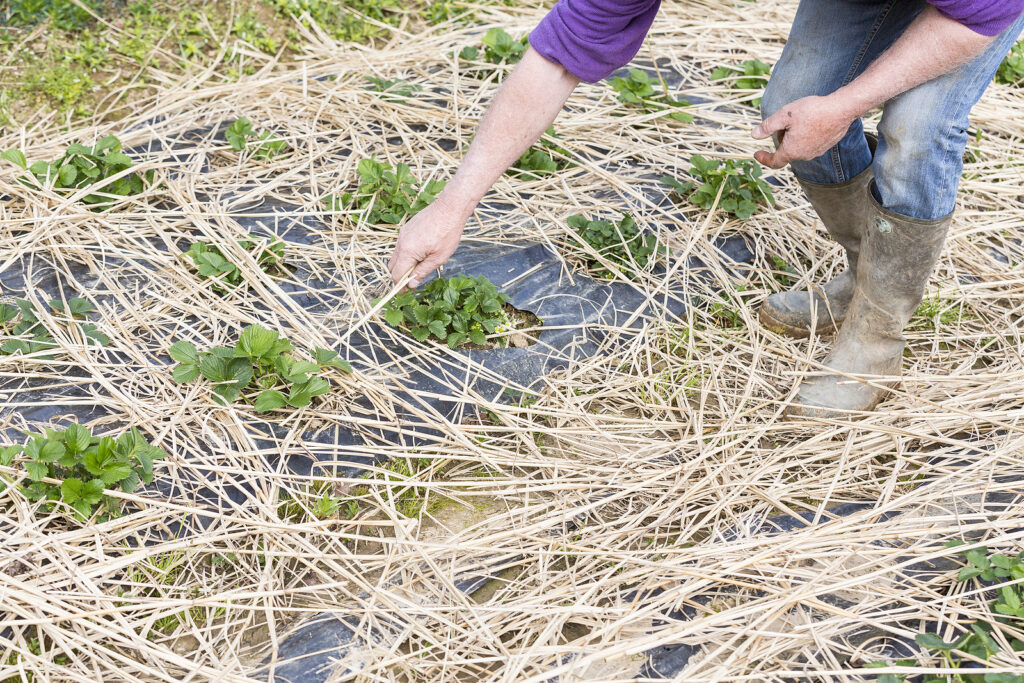
How to grow strawberries in hot summer regions
The secret to getting a good strawberry harvest in hot summer climates—where daytime temperatures are consistently greater than 85°F–is to have strawberries ready for picking in mid-winter, not in late spring or early summer as in cooler summer regions. Early spring is the traditional time to set out strawberries but where summers are hot, a spring planting will be disappointing.
Strawberries are easy to grow but can be difficult to grow well. Strawberries come to harvest after four or five months of growth. Well-established plants are the best producers. Where summers are hot, set out new strawberry plants in late summer so that they establish themselves in cooling not warming weather, and are ready for harvest in midwinter; in the northern hemisphere set out plants in September for harvest in January.
Strawberries want to flower and come to harvest in cool to warm weather. The ideal temperature for strawberry growing is 60°F to 80°F; those temperatures allow strawberries to develop strong roots and take up nutrients necessary to produce lots of flowers and fruit. Weak plants will not produce a strong harvest and commonly will not survive summer heat–sustained temperatures of 85°F or greater. (That means a spring planting of strawberries in hot summer regions is a waste of time and effort.)
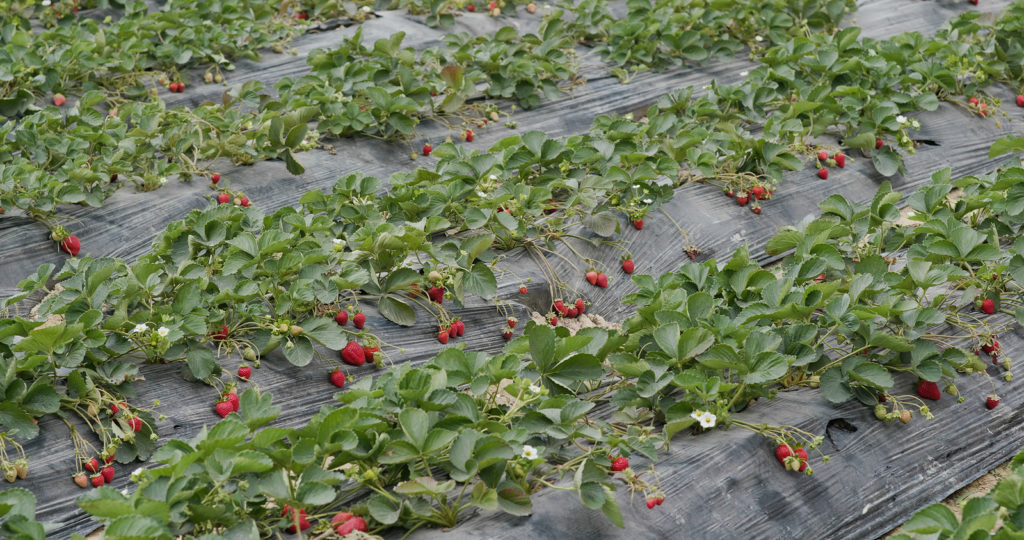
Year-round warm climate growing strategy
Late summer and fall. Plant strawberries in late summer when the days are cooling, but the soil remains warm. This is the time of year older plants will also begin to revive. Fall is not the usual time to find strawberries in nurseries or garden centers; you may have to call on strawberry-growing friends to give you strong plants or established runners. Set plants into compost-rich, well-drained soil at the same level they were growing before. Do not set the crown of the plant too high or it will dry out; do not set plant crowns too low or they will rot. Water transplants into place and adjust plants if they settle too deeply. Set plants about 12 inches apart allowing space for runners that will follow to fill in the bed.
Fall and early winter. Grow strawberries on during the cool time of the year. Keep the soil around establishing strawberries moist, but not wet. If leaves turn pale green with dark-colored veins ease up on the watering. Water strawberries to a depth of 12 inches and then allow the soil to dry out for a few days. Adding aged compost around plants is the best fertilizer you can give them; you can never add too much compost to your growing beds. If you use a commercial fertilizer, choose one rich in phosphorus and potassium and be sure to follow the directions and not overfeed plants.
When the weather turns cold, cover the bed with a portable plastic tunnel–a sheet of clear plastic (4 to 6 millimeters thick) set over a frame of half hoops or wire construction mesh; strawberries can withstand a few nights of frost, but not a sustained freeze. Be sure to ventilate the tunnel on warm days by opening the ends to fresh air. On freezing nights, put a tarp or blanket over the frame to keep it warm.
Strawberries will begin to flower and set fruit when the temperatures warm and days grow longer. If your strawberries are well established, you can expect plants to fruit abundantly until the temperatures climb into the high 80°sF.
Mid- to late-winter and spring. While the soil is still warm, spread straw around plants to keep the berries clean when plants set fruit. (You can also grow strawberries through plastic or garden fabric; set the plastic or fabric across the bed before planting.) Place straw around plants so that air can circulate beneath. When strawberries begin to ripen be sure to check them every day; pick the fruit when it turns completely red but before it gets soft—it’s ok for the berries to be slightly white at the end; they will continue to ripen for a few days after picking. If you don’t need new plants, pinch away runners and let established plants grow stronger.
Summer. Shade the strawberry growing bed during the summer to reduce stress on plants and to keep plants from burning or drying out in the summer heat. Replace the clear plastic sheeting atop the hoop tunnel with 65 percent shade cloth, or place a thick layer of fresh straw atop the growing bed covering both plants and soil to keep the sun off the leaves. Again, water to a depth of 12 inches (you can check the water depth with a soil probe) allowing the straw to dry out between waterings; avoid too frequent waterings so that snails and pillbugs don’t get comfortable in the strawberry bed and mold does not begin to grow.
Year-round container growing. In hot summer regions or any region, strawberries are suited for container growing. Mobile containers will allow you to take strawberries out of summer heat and winter cold. Select a container that is deep enough for strawberry roots—12 to 15 inches—and well-drained. Terra-cotta or plastic strawberry pots with cup-shaped pockets around the sides are designed for multiple plants and a modest harvest. Water plants regularly, and feed plants weekly with a high potassium-low nitrogen fertilizer once flowering starts.
Growing strawberries in winter
- Day-neutral strawberries will continue to fruit regardless of the length of day as long as temperatures do not drop below 50° Strawberries will continue to fruit in winter in mild-winter regions.
- Day-neutral strawberries will continue to grow and fruit indoors.
- Grow day-neutral strawberries under plastic tunnels or cloches in winter.

How to plan a year-round strawberry harvest
Strawberries are the first fruit of spring. They can also be one of the last fruits harvested in autumn, and they are a winter crop in many regions.
To get a long harvest of strawberries, choose a combination of early harvest, mid-season harvest, and late-season harvest June-bearing strawberries, and also plant everbearing, and day-neutral varieties.
Strawberry plants are productive for two to three years. Plan to always have first, second, and third-year plants growing in your garden. Replace three-year-old plants with new plants every year. Nearly all garden strawberries produce runners; allow runners to root and then transplant them to spots where third-year plants have just been removed or to a new planting bed. Runner production increases in number from day-neutral (the fewest) to ever-bearing to June-bearing types; alpine strawberries do not send out runners.
Plant labels will describe fruit size, firmness, and flavor intensity. Firmer fruit cultivars are better for freezing and preserving.
The three types of garden strawberries are June-bearing, everbearing, and day-neutral strawberries. Alpine strawberries are a form of wild strawberry; while they are delicious, they are very small, and production is limited.
- June bearing: these strawberries ripen a single crop each year, usually in late spring or early summer. These strawberries will set fruit the year after they are planted. Some are harvested early, others later, and others late.
- Ever-bearing: these strawberries bear two crops each year; the first crop comes in summer and is small; the second crop comes in fall and is larger. Ever-bearers produce their first crop the same year they are planted. Sometimes they are grown as annuals and not wintered over for a second or third year. Ever-bearers grow best where late summer weather is cool, not hot.
- Day-neutral: these strawberries bear fruit in spring, summer, and fall–throughout the growing season as long as the temperature remains between 35°F and 85° They will even produce fruit in winter if temperatures do not drop below 35°F. Day-neutral strawberries were developed from everbearing strawberries. They will bear fruit about 12 weeks after planting. They can be grown as annuals,
There are dozens and dozens of strawberries to choose from. Check with a nearby garden center or the local Cooperative Extension Service for cultivars that grow well in your region.
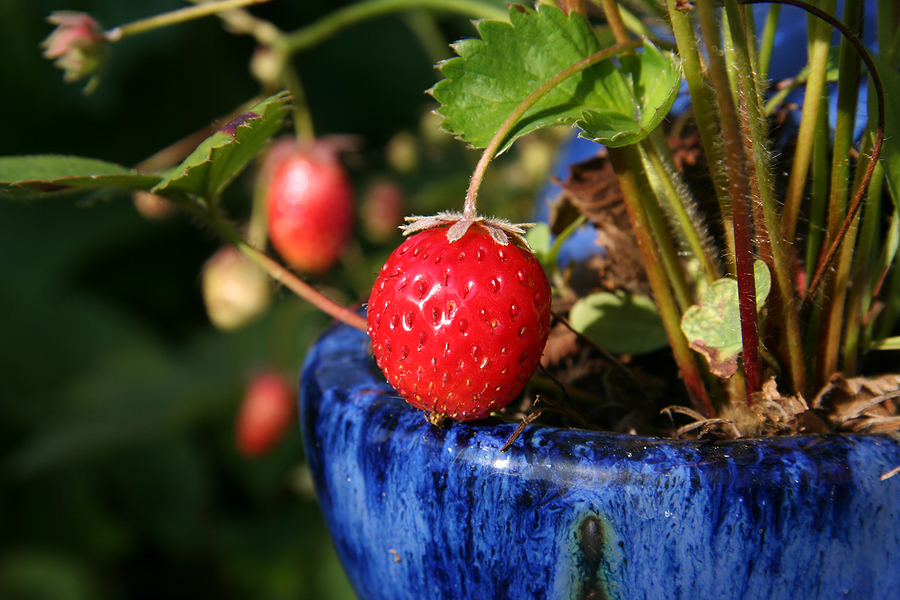
Everbearing and day-neutral strawberry varieties
- ‘Albion’: grows well in most regions; day-neutral.
- ‘Aptos’: grows well in California; everbearing.
- ‘Brighton’: grows well in California; everbearing.
- ‘Chandler’: large, juicy, glossy red berries; excellent flavor; good texture; grows well in southern regions; everbearing.
- ‘Fern’: medium to large, bright red berries; firm flesh, sweet flavor; good runner production; grows well in most regions; everbearing.
- ‘Fort Laramie’: medium to large berries; firm flesh; excellent flavor; abundant runners; grow well in central states and west; everbearing.
- ‘Gem’: small, deep red berries; tart flavor; good dessert quality; grows well in northeast and Midwest; everbearing.
- ‘Geneva’: soft, flavorful berries; grows well in northeast and Midwest; everbearing.
- ‘Hecker’: large bright red berries; excellent flavor; use fresh or preserve; grows well in California; day-neutral.
- ‘Ogallala’: medium size dark red berries; soft flesh, tart flavor; good for freezing; grows well in northeast and Midwest; everbearing.
- ‘Ozark Beauty’: medium size, glossy red fruit; excellent flavor; best in cold winter regions; grows well in northeast and Midwest; everbearing.
- ‘Quinault’: large, soft fruit; excellent for freezing; heavy bearing late in the season; good runner production; everbearing.
- ‘Selva’: large, deep red berries; mild flavor; best in warm regions; resists red stele; day-neutral.
- ‘Seascape’: large berries; good for fresh eating and preserving; grow as annuals in cold winter regions; day-neutral.
- ‘Tribute’: medium to large glossy red fruit; tart flavor; disease resistant; grows well in most regions; day-neutral.
- ‘Tristar’: medium-size, deep red berries; excellent flavor; resistant to red stele and verticillium wilt; widely adapted, grows well in most regions; day-neutral.
- ‘Yolo’: medium-size fruit; compact plant; resistant to verticillium.; day-neutral.
June-bearing strawberry varieties
Early season harvest
- ‘Blakemore’: small, firm bright red berries; rich flavor; excellent for preserves; good runner production; grows well in southern regions; June bearing.
- ‘Cyclone’: large, brilliant red, flavorful fruit; resists leaf diseases; grows well in northeast and Midwest; June bearing.
- ‘Darrow’: medium-large, deep red berries; firm flesh; good flavor; a moderate number of runners; June bearing.
- ‘Dixieland’: medium to large, firm berries; acidic flavor; excellent for freezing; grows well in southern regions; June bearing.
- ‘Douglas’: large deep red fruit; firm flesh; excellent flavor; high sugar content; suited to California; June bearing.
- ‘Dunlap’: medium size, light red fruit; hardy plant; grows well in northeast and Midwest; June bearing.
- ‘Earlibelle’: medium to large, firm bright red berries; good for canning and freezing; good runner production; grows well in southern regions; June bearing.
- ‘Earliglow’: June-bearing; medium size, rich red berries; excellent flavor; grows well in northeast and Midwest; June-bearing.
- ‘Empire’: large, light red berries; dessert quality; very productive; good in northern regions; June bearing.
- ‘Fairfax’: medium size, purplish-red fruit when ripe; dessert quality; June bearing.
- ‘Fletcher’: medium-size fruit; excellent flavor; good for freezing; June bearing.
- ‘Midland’: good fresh or frozen; grows well in northeast and Midwest; June bearing.
- ‘Northeaster’: large fruit; grows well in clay soil; resists red stele; grows well in northeast and Midwest; June bearing.
- ‘Premier’: June-bearing; large glossy red berries; juicy; disease and frost resistant; June bearing.
- ‘Sequoia’: large dark red berries; soft flesh; excellent flavor; starts producing early; grows well in southern regions; June bearing.
- ‘Sunrise’: medium size, bright red fruit; dessert quality; produces ample runners; red stele and verticillium resistant; June bearing.
- ‘Tioga’: medium to large, medium red fruit; firm flesh; good flavor; prolific producer; June bearing.
- ‘Titan’: large, berries; firm flesh; good flavor; high yield; June bearing.
- ‘Tufts’: large, even red fruit; dessert quality; high sugar content with some tartness; June bearing.
- ‘Veestar’: medium size, glossy red fruit; moderately firm flesh; slightly tart, excellent flavor; June bearing.
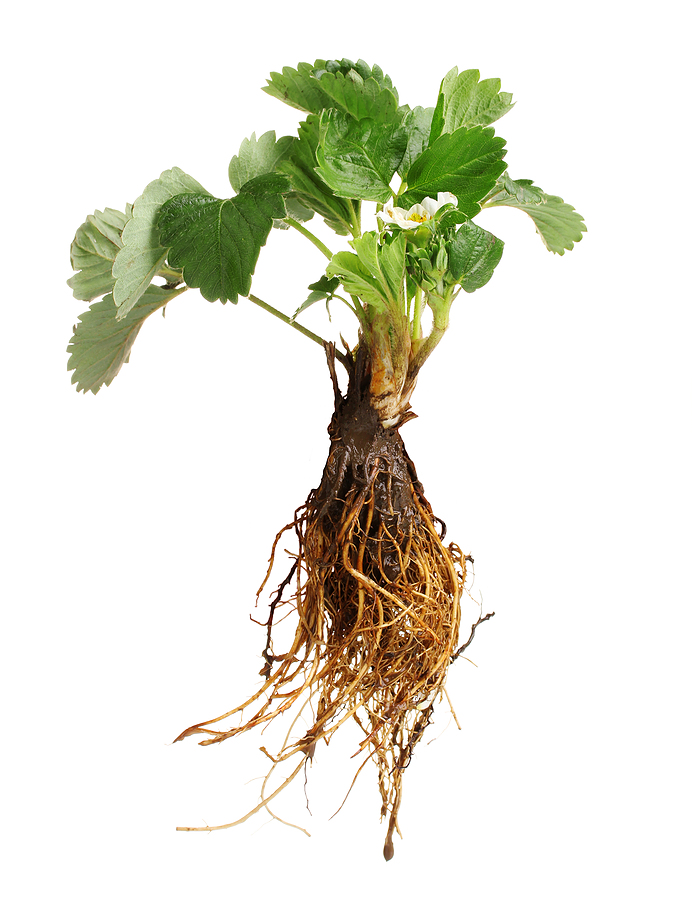
Midseason harvest varieties
- ‘Allstar’: June-bearing.
- ‘Cardinal’: large, firm uniformly red berries; sweet flavor; for fresh eating and processing; resists leaf spot, powdery mildew, leaf scorch; grows well in southern regions; June bearing.
- ‘Catskill’: large glossy, bright crimson berries; good dessert quality; excellent for freezing; grows well in northeast and Midwest; June bearing.
- ‘Douglas’: large, firm berries; grows well in California; June bearing.
- ‘Florida Ninety’: large berries; good flavor; good yield; good runner production; grows well in southern regions; June bearing.
- ‘Glooscap’: medium to large, glossy red berries; excellent flavor and quality; makes runners freely; best in cool and wet climates; June bearing.
- ‘Guardian’: large, light red berries; good flavor; good for desserts; freezes well; disease resistant; good in cold winter regions; grows well in northeast and Midwest; June bearing.
- ‘Headliner’: good quality; good fruit and runner production; resists leaf spot; grows well in southern regions; June bearing.
- ‘Holiday’: large fruit; good production; grows well in northeast and Midwest; June bearing.
- ‘Honeoye’: large, bright red berries; sweet-tart flavor; good in cold regions; grows well in northeast and Midwest; June bearing.
- ‘Hood’: large, conical, medium-red berries; excellent flavor for fresh eating or processing; early ripening; grows well in northeast and Midwest; June bearing.
- ‘Jewel’: large, firm, bright red berries; best in cold winter regions; grows well in northeast and Midwest; June bearing.
- ‘Kent’: very large, dark red berries, firm flesh; for fresh eating and frozen desserts; produces ample runners; adapted to northern climates, winter hardy; June bearing.
- ‘Lester’: large, deep red berries; firm flesh, mild flavor; resists red stele; susceptible to verticillium; June bearing.
- ‘Midway’: large, deep red glossy berries; dessert-quality fruit; susceptible to leaf spot and verticillium wilt; grows well in northeast and Midwest; June bearing.
- ‘Northwest’: medium to large firm, bright red berries; flavorful; good fresh or in preserves; grows well in the northwest; June bearing.
- ‘Olympus’: June-bearing; medium to large fruit; resists red stele and viral diseases; grows well in northwest
- ‘Pocahontas’: June-bearing; good frozen and in preserves; resists leaf scorch; grows well in southern regions also in the northeast; June bearing.
- ‘Puget Beauty’: large, light crimson fruit; flavorful; excellent fresh and for freezing and preserves; resists mildew; June bearing.
- ‘Rainier’: large berries; flavorful; tolerates root rot; grows well in the northwest; June bearing.
- ‘Raritan’: large, glossy, bright red berries; firm flesh; dessert quality; productive; susceptible to red stele and wilt; June bearing.
- ‘Redchief’: medium size, firm, deep red berries; very productive; resists red stele (root rot); June bearing.
- ‘Red Coat’: medium to large, light red glossy berries; firm flesh; good for freezing and jam; resist powdery mildew; June bearing.
- ‘Robinson’: medium to large, red berries; mild flavor; virus disease tolerant; drought-resistant; June bearing.
- ‘Royal Sovereign’: large, bright red berries; excellent flavor; susceptible to disease; June bearing.
- ‘Scott’: large fruit, bright red fruit; firm flesh; mild flavor; freezes well; resistant to red stele; verticillium tolerant; June bearing.
- ‘Sequoia’: large berries; good for freezing and preserves; moderate runner production; June bearing.
- ‘Shasta’: large berries; good for freezing and preserves; June bearing.
- ‘Snow White’: small to medium, white fruit; mild flavor; June bearing.
- ‘Sparkle’: midseason medium size, dark red, glossy fruit; soft flesh; excellent for dessert and freezing; powdery mildew resistant; grows well in northeast and Midwest; June bearing.
- ‘Surecrop’: large, firm bright red fruit; tart flavor; good dessert quality; resists diseases; grows in all regions; June bearing.
- ‘Suwannee’: medium to large fruit; excellent flavor; grows well in southern regions; June bearing.
- ‘Tangi’: medium-large fruit; excellent flavor; good disease resistance; June bearing.
- ‘Tennesse Beauty’: June-bearing; medium size, medium to deep red berries; good flavor; good fresh or frozen; grows well in southern regions; June bearing.
- ‘Vermillion’: very hardy; June bearing.
- ‘White Pine’: small fruit, glossy white skin; moderately productive; June bearing.
Late-season harvest varieties
- ‘Apollo’: large, deep scarlet berries; sweet flavor; grows well in southern regions; June bearing.
- ‘Albritton’: large berries; rich flavor; for freezing; grows well in southern regions; June bearing.
- ‘Arking’: grows well in southern regions; June bearing.
- ‘Benton’: soft berries; good flavor; virus tolerant, mildew resistant; grows well in northeast and Midwest; June bearing.
- ‘Canoga’: large red, sweet fruit; heavy production; grows well in northeast and Midwest; June bearing.
- ‘Camarosa’: conical berries; susceptible to mildew; grows well in southern regions; June bearing.
- ‘Crimson King’: grows well in the Northeast and Midwest; June bearing.
- ‘Daybreak’: large berries; good flavor; good for preserving; vigorous plants; grows well in southern regions; June bearing.
- ‘Delite’: medium to large, bright red fruit; good flavor, dessert quality; very productive; June bearing.
- ‘Fletcher’: medium to large fruit, medium red, glossy fruit; juicy; mild flavor; good for freezing; grows well in northeast and Midwest; June bearing.
- ‘Howard 17’ (‘Premier’): medium size berries; good quality; disease resistant; grows well in northeast and midwest; June bearing.
- ‘Jerseybelle’: large, medium red fruit; mild flavor; few runners; moderate production; June bearing.
- ‘Marlate’: very large bright red fruit; sweet flavor; good fresh and freezes well; very hardy; grows well in southern regions; June bearing.
- ‘Puget Beauty’: grows well in the northwest; June bearing.
- ‘Puget Reliance’: large, tasty berries; excellent flavor; virus tolerant; grows well in the northwest; June bearing.
- ‘Puget Summer’: heavy yield, late-season; sweet flavor; susceptible to powdery mildew; grows well in the northwest; June bearing.
- ‘Redchief’: grows well in southern regions; June bearing.
- ‘Redstar’: large fruit; good dessert quality; resists viral disease; grows well in northeast and Midwest; June bearing.
- ‘Robinson’: large berries; good yield; long harvest; grows well in northeast and Midwest; June bearing.
- ‘Sequoia’: very tasty; widely adapted; grows well in California; June bearing.
- ‘Shasta’: grows well in California; June bearing.
- ‘Sunrise’: firm berries; very good flavor; not for freezing; resists diseases; grows well in southern regions; June bearing.
- ‘Surecrop’: grows well in southern regions; June bearing.
- ‘Toklat’: large, sweet berries; susceptible to botrytis; grows well in northeast and Midwest; June bearing.
- ‘Trumpeter’: large, bright red fruit; firm, juicy flesh; slightly tart; grows well in northeast and Midwest; June bearing.
- ‘Vesper’: medium size, glossy light red fruit; good flavor; ripens rapidly; grows well in the east; June bearing.
Strawberry varieties to grow by region
- California and Southwest: ‘Camarosa’ ‘Chandler’ ‘Douglas’, ‘Lassen’, ‘Marshall’, ‘Quinault’, ‘Sequoia’, ‘Shasta’
- East: ‘Fletcher’, ‘Guardian’, ‘Holiday’, ‘Jerseybelle’, ‘Marlate’, ‘Ozark Beauty’, ‘Raritan’, ‘Redchief’, ‘Sunrise’, ‘Vesper’
- Mid-Atlantic Coast: ‘Pocahontas’, ‘Raritan’, ‘Surecrop’
- Midwest: ‘Canoga’, ‘Catskill’, ‘Cyclone’, ‘Dunlap’, ‘Earliglow’, ‘Fletcher’, ‘Gem’, ‘Geneva’, ‘Guardian’, ‘Holiday’. ‘Howard 17’, ‘Jewel’, ‘Midland’, ‘Midway’, ‘Ogallala’, ‘Ozark Beauty’, ‘Robinson’, ‘Sparkle’, ‘Surecrop’
- Mid-South: ‘Ozark Beauty’, ‘Suwannee’, ‘Tennessee Beauty’
- North: ‘Dunlap’, ‘Empire’, ‘Fairfax’, ‘Fletcher’, ‘Jewel’, ‘Premier’, ‘Robinson’
- Northeast: ‘Canoga’, ‘Catskill’, ‘Cyclone’, ‘Dunlap’, ‘Earliglow’, ‘Fairfax’, ‘Fletcher’, ‘Gem’, ‘Geneva’, ‘Guardian’, ‘Holiday’. ‘Howard 17’, ‘Jewel’, ‘Midland’, ‘Midway’, ‘Northeaster’, ‘Redstar’, ‘Robinson’, ‘Sparkle’, ‘Red Coat’, ‘Sparkle’, ‘Trumpeter’
- Northwest: ‘Hood’, ‘Northwest’, ‘Olympus’, ‘Puget Beauty’, ‘Quinault’, ‘Rainier’, ‘Selva’, ‘Totem’, ‘Tribute’
- South and Gulf Coast: ‘Albritton’, ‘Blakemore’, ‘Cardinal’, ‘Daybreak’, ‘Dixieland’, ‘Earlibelle’, ‘Florida Ninety’, ‘Guardian’, ‘Headliner’, ‘Marlate’, ‘Pocahontas’, ‘Redchief’, ‘Sunrise’, ‘Surecrop’, ‘Suwannee’, ‘Tennessee Beauty’, ‘Tangi’
- Southern Plains: ‘Cardinal’, ‘Pocahontas’, ‘Trumpeter’
- Upper Plains and the Rockies: ‘Cyclone’, ‘Dunlap’, ‘Fort Laramie’, ‘Ogallala’, ‘Sparkle’, ‘Trumpeter’.
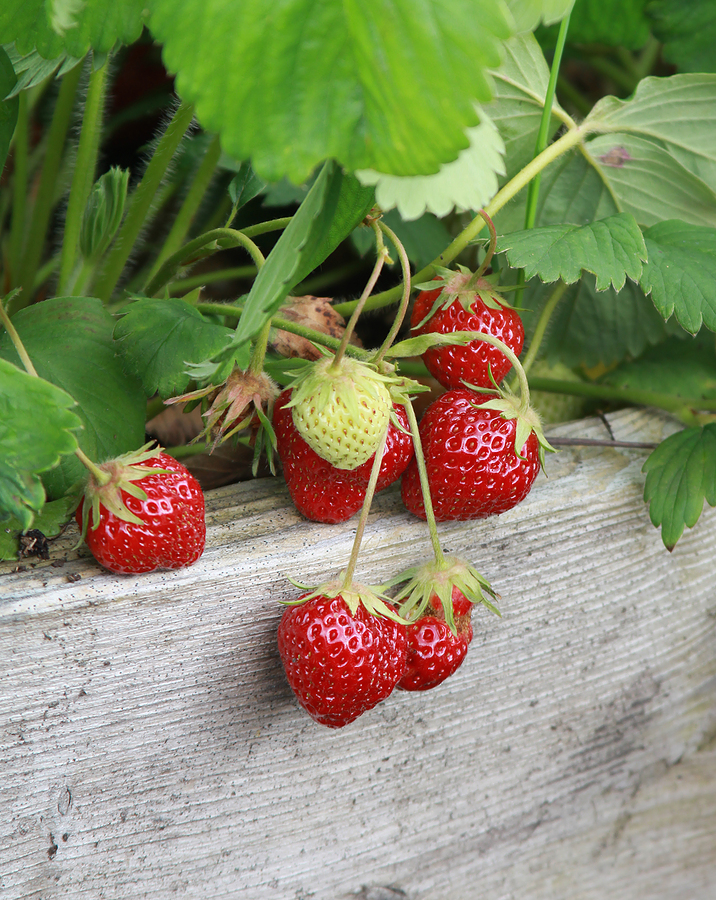
Harvesting strawberries
- For a long harvest plant some of each type of strawberry, June-bearers, ever-bearers, and day-neutrals.
- Strawberries ripen about 30 days after flowering. Check plants every day; berries ripen quickly.
- Pick berries when they are full-colored, tender, and sweet. Pinch off the stem when you harvest and avoid pulling the berry itself. Ripe berries along with their cap will separate easily from the stem.
Storing strawberries
- Fruit can be refrigerated for a few days, not more than a week; freeze berries for longer storage. For storing, pick berries when the ends are slightly white; they will continue to ripen and will keep in the refrigerator for a couple of days.
- Don’t leave rotting berries in the garden; dispose of them; removing rotting fruit will prevent the spread of disease.
Botanical Name: Fragaria vesca
The strawberry is a member of the Rosaceae or rose family; other members of this family are apples, pears, quinces, apricots, plums, cherries, peaches, raspberries, and loquats.
Also of interest:
Related articles:
Planning the Home Fruit Garden
Garden Planning Books at Amazon:
- Vegetable Garden Grower’s Guide
- Tomato Grower’s Answer Book
- Vegetable Garden Almanac & Planner
- Kitchen Garden Grower’s Guide Vegetable Encyclopedia
More fruit-growing articles:
Learn how to plant, grow, prune, and harvest your favorite fruits. Click below for all you need to know.
- Apple
- Apricot
- Avocado
- Banana
- Blackberry
- Blueberry
- Cantaloupe
- Chayote
- Cherimoya
- Cherry
- Citrus
- Clementine
- Cranberry
- Currants
- Elderberry
- Feijoa
- Fig
- Gooseberry
- Grape
- Grapefruit
- Guava
- Kiwifruit
- Kumquat
- Lemon
- Lime
- Loquat
- Mandarin
- Mango
- Melon
- Mulberry
- Muskmelon
- Nectarine
- Olive
- Orange
- Papaya
- Passion Fruit
- Peach
- Pear
- Persimmon
- Pineapple
- Pineapple Guava
- Plantain
- Plum
- Pomegranate
- Pumpkin
- Quince
- Raspberry
- Strawberry
- Tangelo
- Tangerine
- Tangor
- Watermelon















